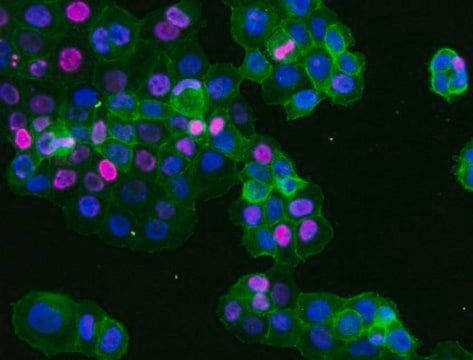AC111P
Sheep Anti-Mouse IgG Antibody, Species absorbed Antibody, HRP conjugate
from sheep, peroxidase conjugate
Sign Into View Organizational & Contract Pricing
All Photos(2)
About This Item
UNSPSC Code:
12352203
eCl@ss:
32160702
NACRES:
NA.41
Recommended Products
biological source
sheep
Quality Level
conjugate
peroxidase conjugate
antibody form
purified antibody
antibody product type
secondary antibodies
clone
polyclonal
species reactivity
mouse
technique(s)
western blot: suitable
shipped in
ambient
target post-translational modification
unmodified
General description
Immunoglobulin G (IgG) is part of the family of glycoprotein immunoglobulins which stage immune responses against pathogenic organisms. IgG contributes to the immune response by mobilizing innate immune effector cells and inducing and pro-inflammatory responses. Such proinflammatory responses are mediated by Fc receptors which interact with sialylated Fc fragments on IgG molecules.
Specificity
Based on ELISA analysis using the unconjugated antibody (Cat. No. AC111), this antibody reacts with whole molecule mouse IgG (IgG>>IgG2a>IgG>>>>IgG1) with minimal or no cross-reactivity toward mouse IgA or IgM.
This antibody has been species absorbed and tested by ELISA prior to conjugation to ensure minimal cross-reaction toward chicken IgY or IgG from human, rat, rabbit, guinea pig, and hamster species, but may cross-react with immunoglobulins from other species.
Immunogen
Purified mouse IgG.
Application
Research Category
Secondary & Control Antibodies
Secondary & Control Antibodies
Research Sub Category
All
All
Sheep Anti-Mouse IgG, Species absorbed, HRP conjugate, Cat. No. AC111P, is a secondary antibody HRP conjugate, validated for use in Western Blotting application with little or no cross-reactivity toward mouse IgA & IgM, chicken IgY or IgG from human, rat, rabbit, guinea pig, and hamster species.
Western Blotting Analysis: Performance of a representative lot was validated at a 1:4,000 dilution for target band labeling following a mouse monoclonal GAPDH antibody (Cat. No. MAB374) in Western blotting application using 10 µg of HeLa cell lysate.
Quality
Evaluated by Western Blotting in A431 cell lysate.
Western Blotting Analysis: Performance of this HRP-conjugated secondary antibody (Cat No. AC111P) is validated at a 1:4,000 dilution for target band labeling following a mouse monoclonal GAPDH antibody (Cat. No. MAB374) in Western blotting application using 10 µg of A431 cell lysate.
Western Blotting Analysis: Performance of this HRP-conjugated secondary antibody (Cat No. AC111P) is validated at a 1:4,000 dilution for target band labeling following a mouse monoclonal GAPDH antibody (Cat. No. MAB374) in Western blotting application using 10 µg of A431 cell lysate.
Target description
~150.0 kDa observed.
Linkage
Replaces: AP300P
Physical form
Ammonium Sulfate.
Purified sheep polyclonal antibody in PBS with StabilZyme® HRP Conjugate Stabilizer and 0.05% Proclin.
Storage and Stability
Stable for 1 year at 2-8°C from date of receipt.
Other Notes
Concentration: Please refer to lot specific datasheet.
Legal Information
StabilZyme is a registered trademark of SurModics, Inc.
Disclaimer
Unless otherwise stated in our catalog or other company documentation accompanying the product(s), our products are intended for research use only and are not to be used for any other purpose, which includes but is not limited to, unauthorized commercial uses, in vitro diagnostic uses, ex vivo or in vivo therapeutic uses or any type of consumption or application to humans or animals.
Not finding the right product?
Try our Product Selector Tool.
Signal Word
Warning
Hazard Statements
Precautionary Statements
Hazard Classifications
Aquatic Chronic 3 - Skin Sens. 1
Storage Class Code
12 - Non Combustible Liquids
WGK
WGK 3
Flash Point(F)
Not applicable
Flash Point(C)
Not applicable
Certificates of Analysis (COA)
Search for Certificates of Analysis (COA) by entering the products Lot/Batch Number. Lot and Batch Numbers can be found on a product’s label following the words ‘Lot’ or ‘Batch’.
Already Own This Product?
Find documentation for the products that you have recently purchased in the Document Library.
Jian Shen et al.
Journal of cellular and molecular medicine, 25(11), 5269-5282 (2021-05-07)
The blood-brain barrier (BBB) damage is a momentous pathological process of ischaemic stroke. NADPH oxidases 4 (NOX4) boosts BBB damage after ischaemic stroke and its expression can be influenced by microRNAs. This study aimed to probe into whether miR-92b influenced
Wenling Dai et al.
International journal of molecular medicine, 44(4), 1197-1204 (2019-08-23)
Melatonin (N‑acetyl‑5‑methoxytryptamine; MT) has been shown to have a protective effect against sepsis‑induced renal injury, however, the mechanisms underlying the function of MT remain to be elucidated. Therefore, in the present study, the potential mechanisms underlying the preventive role of
Xiaojing Sun et al.
Journal of molecular and cellular cardiology, 140, 68-76 (2020-03-10)
The large conductance Ca2+-activated K+ (BK) channels, composed of the pore-forming α subunits (BK-α, encoded by KCNMA1 gene) and the regulatory β1 subunits (BK-β1, encoded by KCNMB1 gene), play a unique role in the regulation of coronary vascular tone and
Julien Bensalem et al.
Autophagy, 17(10), 3238-3255 (2020-11-10)
Autophagic flux is a critical cellular process that is vastly under-appreciated in terms of its importance to human health. Preclinical studies have demonstrated that reductions in autophagic flux cause cancer and exacerbate chronic diseases, including heart disease and the pathological
Qiang Yao et al.
Experimental and therapeutic medicine, 15(3), 3088-3095 (2018-02-20)
Gastric cancer (GC) poses a serious public health threat and the 5-year survival rate of patients with GC is low. MicroRNAs (miRNAs/miRs) may serve oncogenic or tumor suppressor functions during tumorigenesis by regulating cell proliferation, apoptosis, migration and invasion and
Our team of scientists has experience in all areas of research including Life Science, Material Science, Chemical Synthesis, Chromatography, Analytical and many others.
Contact Technical Service









